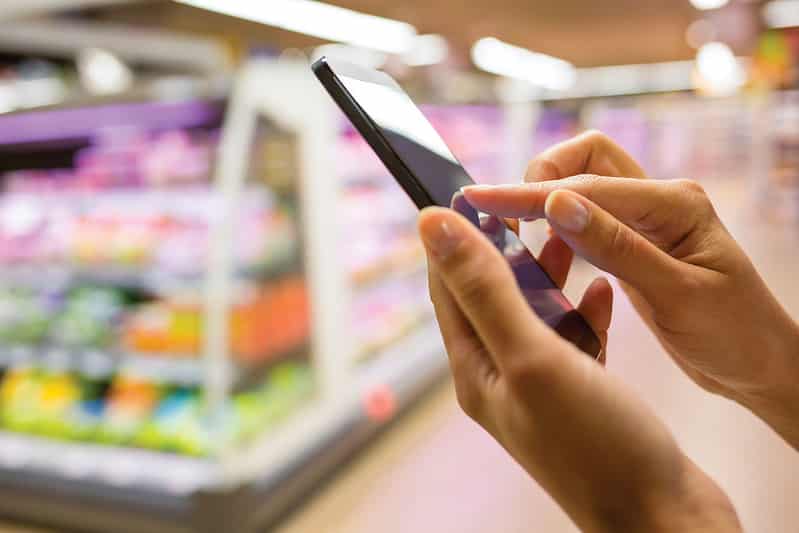
It’s great when a friend or a favorite blogger tells you about a deal. But how about when your phone alerts you to a coupon or a sale?
Ping! Here’s a promotion you might be interested in. Ping! Check out this coupon on an item you might want to buy. Ping! We see you’re currently near this particular store, why not stop in to check out their sales?
It might save you money – or it might cost you your sanity.
Savings apps can be a handy adjunct or alternative to clipping coupons. But when do mobile app push notifications cross the line from helpful to annoying?
The mobile app experience company Airship has released results from a global survey on retail app use, to see how shoppers use them, what features they find most beneficial, and what might drive them away.
“The Mobile Customer Imperative” found that two-thirds of shoppers regularly use their mobile devices in-store while shopping. While it’s certainly possible to search the internet or dig through emails for information about a deal while walking up and down the aisles, one of the most popular ways to utilize a mobile device while shopping is by accessing an app – either the store’s own app, or a third-party savings app.
After all, emails or texts about coupons and deals are fine. But your email doesn’t know where you are or when you’re ready to shop. An app, in contrast, can be granted access to your location, and can send push notifications right to your phone’s home screen. “Apps have an inherent advantage to reach people wherever they are at the exact moment it matters most,” the report reads. “But how do you get consumers to opt in?” And, just as importantly, how do you prevent them from opting out?
When asked what incentives are most likely to motivate them to opt in to retail app push notifications, the number-one choice among survey respondents was “earning immediate discounts or loyalty reward points,” cited by 35%. Not a vague promise of savings, but actual tangible benefits – think Shopkick, which gives you rewards points just for walking into a store. 21% of those surveyed would like “early access to big sales events or exclusive product drops.”
“Interestingly, two things least likely to motivate smartphone users to opt in are ‘personalized offers based on behavior/past purchases’ and ‘special offers triggered by their location’,” the report found. An app with access to your location might ping you with a reminder to buy a particular product, or to scan your receipt for points after you check out. But those reminders can be more annoying than useful. “Customers want personalized, individualized interactions; you just have to meet them first with immediate value,” Airship advised app providers.
The most common reason for opting out of app notifications was “receiving too many messages too often,” cited by 51%, followed by irrelevant information, messaging that’s “too promotional” and not enough value or discounts. “These are clear warning signals to brands,” the report reads. Their messaging needs to be relevant, timely and valuable, because “once a consumer has opted out, it can be very difficult to get them back.”
It’s a balancing act, though. 25% of shoppers said they’re open to receiving notifications anytime about expiring coupons, while 22% don’t want these types of notifications at all. 21% want immediate notifications about personalized sales alerts, while 25% don’t want these at all. So what one shopper finds helpful, another shopper might find bothersome.
Several recent reports have pointed to the importance of brand emails, declaring that “email marketing is on the rise.” But Airship says apps are overtaking email in importance. More than three-quarters of respondents said they ignore emails about products or promotions, or delete them without reading, at least half of the time. 41% said they often unsubscribe from brand emails, 20% “use a secondary email account that I rarely check,” and 7% admit to “providing fake email addresses.”
“Inundated email inboxes require marketers to get more sophisticated about targeting messages to individuals,” the report states.
Whether shoppers opt in to push notifications or not, retail apps can still be useful and even essential when shopping. 70% of shoppers said they use their mobile device to access loyalty discounts or digital coupons, while 53% are willing to use their phone to scan QR codes in store for discounts or product information. So the more features a retail app has, the more likely a shopper is to regularly use it.
“To gain the insights necessary to meet today’s expectations, brands must provide a more robust mobile app experience with individualized control to reach much deeper into the hearts and minds of their customers,” Airship CEO Brett Caine said in a statement. “Companies must go far beyond targeting ‘eyeballs’ and delivering one-way messaging and brand-centric campaigns to succeed in the customer-first digital future.”
So to some shoppers, the ping of their phone while shopping can represent the sound of savings. Others might prefer their phone to stay silent unless they need it. Marketers will have to figure out how to send the right message to the right shopper using the right method – which could make the difference between an annoyed shopper, and a happy customer.
Image source: rosenfeldmedia











Flawed research IMO. Assumes all shoppers are of equal value and all equally available. Also, a promotion that can move 10% of high value shoppers is a blockbuster, not a dud.